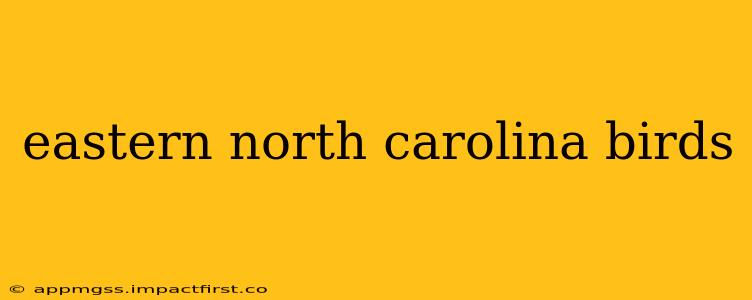Eastern North Carolina boasts a rich avian diversity, thanks to its varied habitats ranging from coastal marshes and maritime forests to inland swamps and agricultural lands. This guide explores the fascinating birdlife of this region, highlighting key species and providing insights into their habitats and behaviors. Whether you're a seasoned birder or a curious newcomer, prepare to discover the feathered wonders of Eastern North Carolina.
What are some common birds in Eastern North Carolina?
Eastern North Carolina offers a spectacular array of bird species. Common sightings include the ubiquitous Northern Cardinal, with its vibrant red plumage, and the melodious Northern Mockingbird, known for its impressive vocal repertoire. Coastal areas often host Brown Pelicans, soaring gracefully overhead, and wading birds like the Great Blue Heron and White Ibis, searching for fish in shallow waters. Inland habitats may reveal the secretive Wild Turkey, the colorful Red-bellied Woodpecker, and the agile Downy Woodpecker. The specific species you encounter will depend heavily on the season and the specific habitat you're exploring.
What birds migrate through Eastern North Carolina?
Eastern North Carolina serves as a crucial stopover point for many migrating birds. During the spring and fall migrations, the skies and wetlands are alive with activity. Look out for warblers such as the Yellow-rumped Warbler, the Black-throated Green Warbler, and the American Redstart, as well as flycatchers like the Eastern Wood-Pewee and the Acadian Flycatcher. Shorebirds, including various sandpipers and plovers, also utilize the coastal areas during their migrations. The timing of these migrations varies, but peak activity generally occurs in spring (April-May) and fall (September-October).
What are the best places to birdwatch in Eastern North Carolina?
Eastern North Carolina offers numerous excellent birding locations. The Pea Island National Wildlife Refuge is a renowned spot for shorebirds and waterfowl, while the Mattamuskeet National Wildlife Refuge provides exceptional opportunities to observe diverse marsh birds. The Croatan National Forest offers a chance to see a variety of woodland species, while the numerous state parks and nature preserves throughout the region provide more localized opportunities for birdwatching. Remember to check specific locations for seasonal closures and access points before your visit.
What time of year is best for birdwatching in Eastern North Carolina?
While birds can be spotted year-round, the best time for birdwatching in Eastern North Carolina is during the spring and fall migrations (April-May and September-October). During these periods, you'll encounter a greater variety of species as birds pass through the area. However, winter offers the chance to observe resident species, and summer brings the activity of nesting birds and their young. Consider researching specific species you're hoping to see, as their peak activity times might vary.
What are some tips for birdwatching in Eastern North Carolina?
Successful birdwatching requires preparation and patience. Bring binoculars, a field guide, and comfortable clothing suitable for the weather conditions. Observe quietly and patiently to avoid disturbing the birds. Learn to identify bird calls, as this can often be more effective than visual identification, especially in dense vegetation. Consider joining a local birding group or attending a guided birdwatching tour to enhance your experience and learn from experienced birders. And most importantly, respect the environment and leave no trace.
What are some rare birds seen in Eastern North Carolina?
While the common species mentioned earlier are regularly observed, Eastern North Carolina occasionally plays host to rarer birds. These sightings are often unpredictable and can depend on weather patterns and migratory routes. Keep an eye on local birding reports and online forums for sightings of unusual species. Some less common but potentially observable species include certain migratory warblers, owls, and shorebirds. Documenting these sightings (with photos if possible) helps contribute to ongoing ornithological research.
This guide offers a starting point for exploring the avian wonders of Eastern North Carolina. Remember that responsible birdwatching involves respecting wildlife and their habitats, contributing to conservation efforts, and appreciating the natural beauty surrounding us. Happy birding!
